Proof that Wharfedale can design great high-end speakers too Tested at £6495
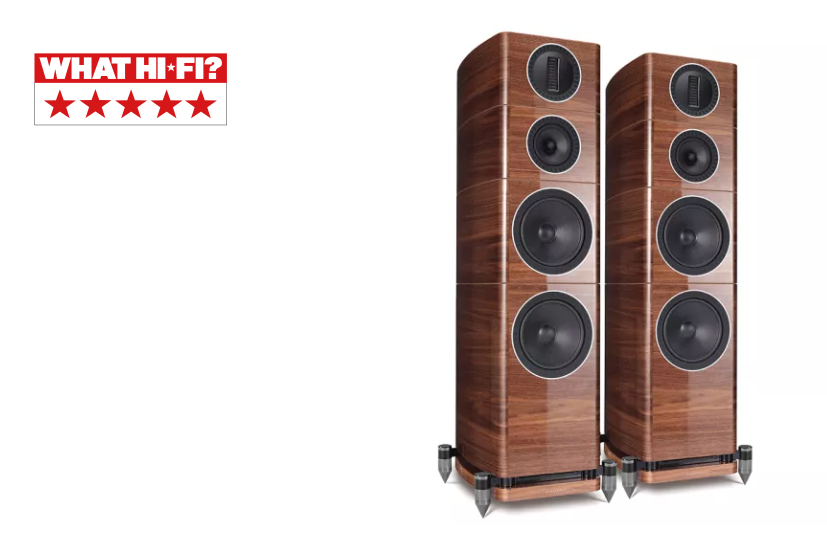
Wharfedale’s Diamond range has been one of the leading contenders at budget price points for more years than we care to remember. The success of this affordable series has spanned almost four decades and, understandably, tended to overshadow the company’s more premium efforts. We don’t think that’s fair, given the excellence of the current Award-winning Evo 4.4 floorstanders and now the hugely ambitious Elysian 4.
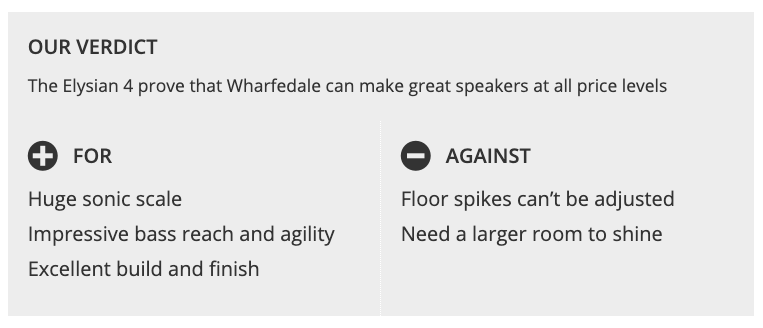
These towers are one half of Wharfedale’s new high-end Elysian range – the other is the Elysian 2 standmounters – and were developed in tandem with the Evo series. While there are common engineering threads between these two ranges, it doesn’t take long to realise that the Elysians represent the full expression of those principles.
Build
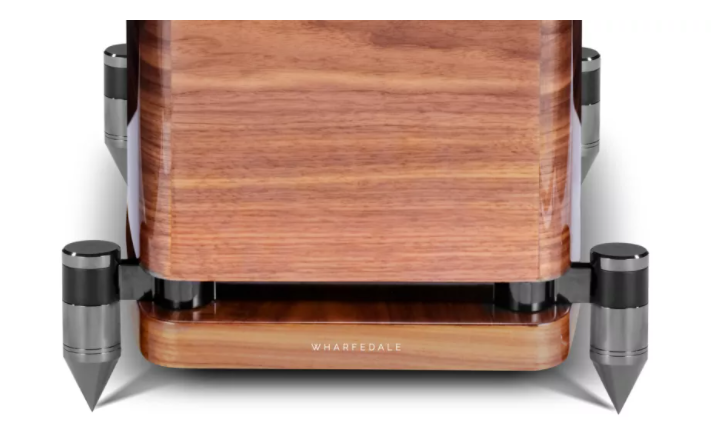
Standing 119cm tall and 40cm wide, the Elysian 4 are big speakers – unusually broad by current standards. They are a three-way design with a 27 x 90mm AMT (Air Motion Transformer) tweeter, 15cm midrange unit and a pair of meaty 22cm bass units. All three of the larger units use a cone made of a woven glass fibre matrix, a proprietary material that is claimed to combine low mass with high strength. In this installation, it’s also covered with a high-plasticity coating for improved damping of internal resonances.
The bass units are tuned by a downward-firing port arrangement of the type we’ve seen on a number of Wharfedale’s speakers in recent years. The port vents through a gap between the base of the main speaker cabinet and the plinth. This arrangement makes the transition from the high air pressure inside the enclosure to the low pressure of the listening room smoother and is claimed to reduce bass distortion, increase efficiency and spread the bass energy more evenly around the room. In practical terms, this makes the Elysian 4 less fussy about room placement than they otherwise might be.
The Wharfedale’s cabinet is more than just a simple wooden box. The front baffle and internal braces are made of high-density fibreboard (HDF), while the rest of the enclosure uses layered MDF and particleboard panels in a bid to control resonances. The cabinet volume is split internally so that the bass units have their own separate space to work in and don’t disturb the midrange’s operation.
The enclosure sits on widely spaced floor spikes, giving the Elysian 4 a solid and stable stance on a level surface, though oddly they can’t be adjusted and locked into position – something to note if you have uneven hard floors.
Wharfedale has finished these speakers beautifully. The towers are available in three classy-looking colour options – walnut, black and white – and covered in a deep, hand-polished piano gloss. While such a gloss finish is hardly rare, this level of quality certainly is. The gloss is wonderfully deep and luxurious, and in our experience unmatched at this level.
It comes as no surprise to find that such big speakers need a decently large space to shine. We manage to get a good balanced sound in our relatively humble listening room, but even then it’s clear that the Elysian 4 would relish more space to breathe.
Compatibility
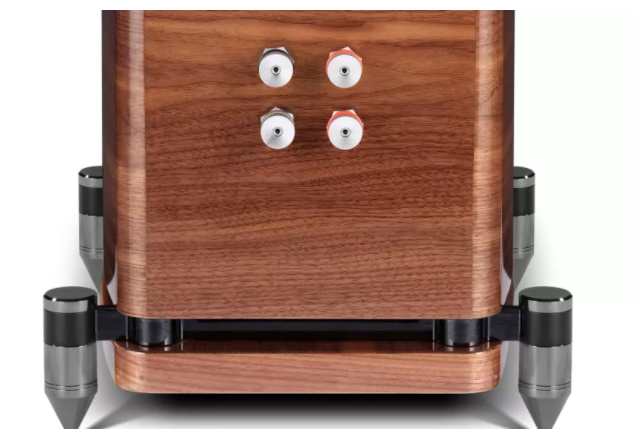
We suggest starting with them at least a metre from the rear wall and as far from the sides as possible. It’s worth playing around with the amount of angling towards the listening position, too. We end up pointing the tweeters so that they cross a little behind our heads, but thanks to the AMT’s relatively even horizontal dispersion there’s enough leeway to experiment.
These are revealing speakers and any compromise with the partnering source or amplification is readily heard. That said, a sensitivity of 92dB/W/m and a nominal impedance that’s rather vaguely described as ‘8ohm compatible’ suggests that lower-powered amplifiers shouldn’t be discounted. Indeed, we get great results with Leben’s CS600X integrated amplifier, with its valve-driven circuitry and modest 28W per channel output.
The bulk of our testing is done with our reference Burmester 088/911 Mk3 pre/power combination fed by Naim’s ND555/555 PS DR music streamer and the Technics SL-1000R record player fitted with a Kiseki Purple Heart MC cartridge. While these components would typically be partnered with pricier speakers than the Wharfedale, we never feel their performance is unduly limited by the Elysian 4.
Sound
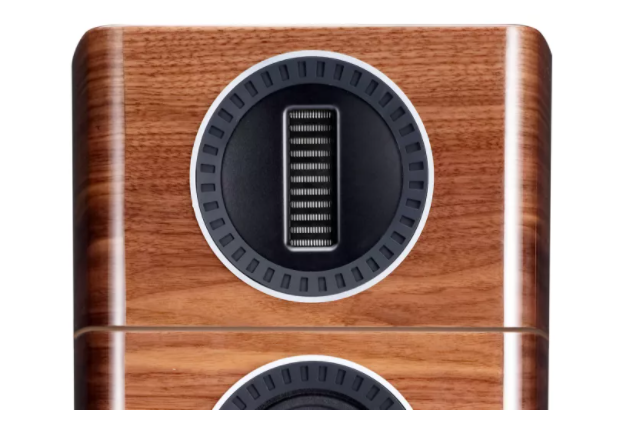
These floorstanders deliver a combination of scale, authority and dynamic punch that most (invariably smaller) price rivals can’t match. This is apparent when we play Tchaikovsky’s 1812 Overture; the Wharfedale’s high volume capability and impressive muscularity come to the fore. They give the music a palpable presence in our listening room and deliver a sense of power that most rivals barely hint at.
Large-scale crescendos are dispatched with confidence, the Elysians punching out sound with real venom. They can play at high volume levels without stress too, but also have the less common attribute of still sounding interesting at whisper levels. This is something to take note of if you listen late at night and don’t want to disturb the neighbours.
Those two 22cm bass drivers do just what we would expect and generate the kind of impressive low-end heft their appearance suggests, giving the presentation a wonderfully solid foundation to work from. If all this talk of muscle and physicality suggests a lack of finesse or subtlety, you’re mistaken. If anything it’s the Elysian 4’s impressively civil nature that appeals to us most.
They have the insight and delicacy to bring Ólafur Arnalds’ Found Songs album – a beloved go-to in our collection – to life. The Wharfedale’s sound is full of detail, which is organised in a natural and intuitive way. We like the way these monster floorstanders express the album’s dynamic nuances and the skill with which they communicate instrumental textures. It’s an unforced presentation that’s comfortable and easy-going without sounding bland. There’s a great deal of analysis on offer, but the musical experience always comes first.
These towers capture the album’s various moods brilliantly, making us feel sad, hopeful or peaceful depending on the track we’re playing. Only the best products manage to communicate the emotions in music this well.
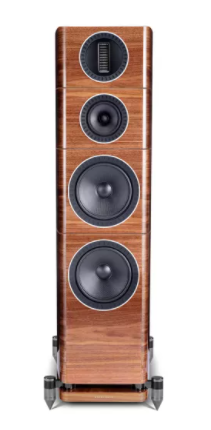 Tonally, these Wharfedales are smooth and admirably refined. Feed them a bright and aggressive recording such as Bruce Springsteen’s Terry’s Song and they won’t hide the rough edges. But neither do they go out of their way to emphasise the shortcomings. That AMT tweeter is a good one: it combines resolution with smoothness, delivering the highs sweetly without lacking bite. And that’s a difficult balance to strike.
Tonally, these Wharfedales are smooth and admirably refined. Feed them a bright and aggressive recording such as Bruce Springsteen’s Terry’s Song and they won’t hide the rough edges. But neither do they go out of their way to emphasise the shortcomings. That AMT tweeter is a good one: it combines resolution with smoothness, delivering the highs sweetly without lacking bite. And that’s a difficult balance to strike.
Stereo imaging is impressive, too. Like most big speakers these towers don’t quite manage to disappear within the soundstage, but they still render a nicely focused and layered image. It’s not the most intimate of presentations, but that’s not a big issue given the Wharfedale’s formidable array of strengths.
Switching between Nina Simone’s Strange Fruit, Kanye West’s Yeezus set and Debussy’s Clare De Lune, we are struck by the Elysian’s transparency. They clearly differentiate between the various recordings, their presentation shifting accordingly. It’s all overlayed with an overriding smoothness and slightly laid-back nature, but that’s easy to hear through.
As we listen, we’re taken by Simone’s passionate delivery, the way each vocal phrase cuts with hurt. The horror and drama in the song comes through without dilution, the Elysian’s clarity through the midrange making it all possible. Kanye West’s album proves these floorstanders can dance if they want to, even if it feels as though they’re a little reserved at times. Clare De Lune highlights the Elysian 4’s lovely treble performance and the way these towers track dynamic shifts so diligently. We’re hooked and have no choice but to listen right to the end, hanging on every last note as we do so.
Verdict
In our view, good value doesn’t come down to how cheap something is; for us it’s about how much you get for the money. In those terms, these big Wharfedales represent excellent value. When it comes to build, engineering content and performance, they have little to fear from any rival.
Provided you have a room large enough to accommodate them, and a suitably talented system, we highly recommend you have a listen. It’s clear that Wharfedale now has another jewel in its crown.
SCORES
- Sound 5
- Compatibility 4
- Build 5

